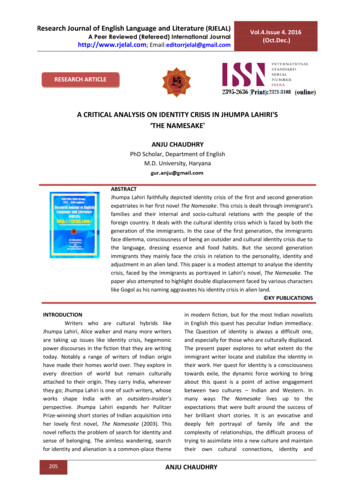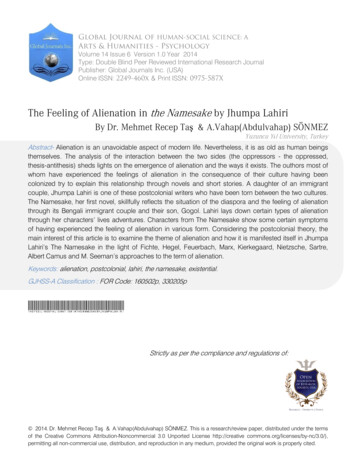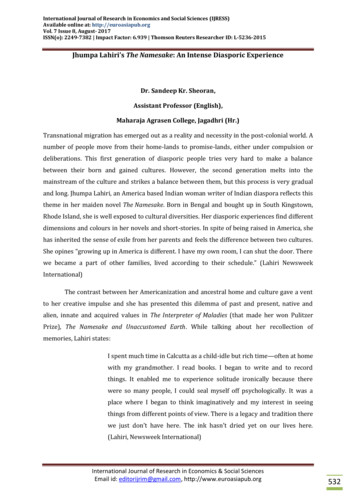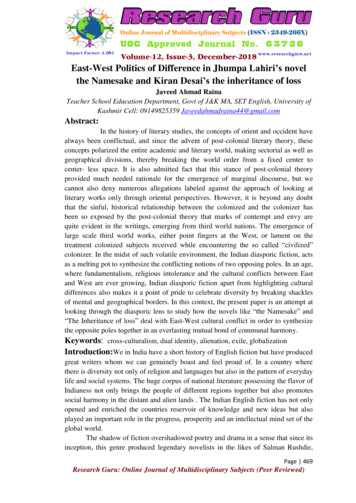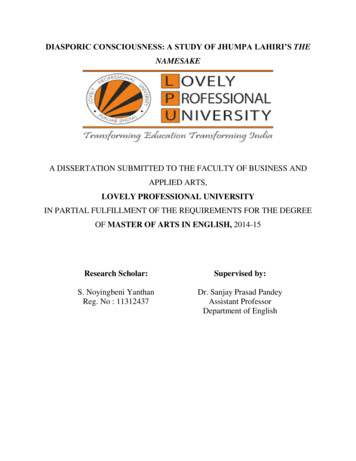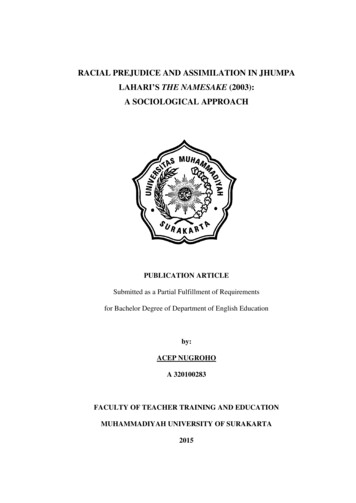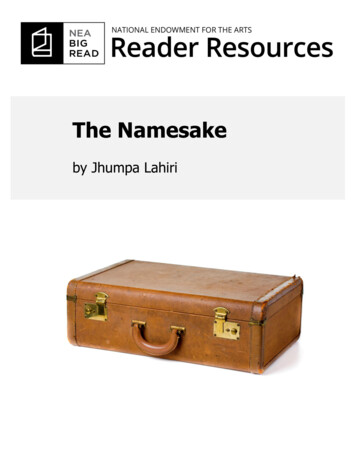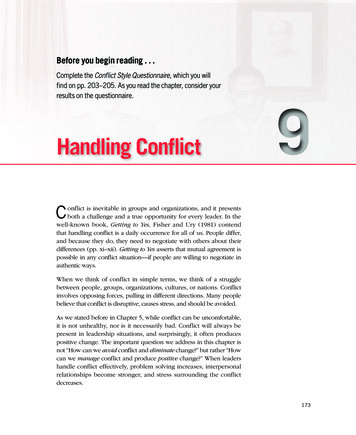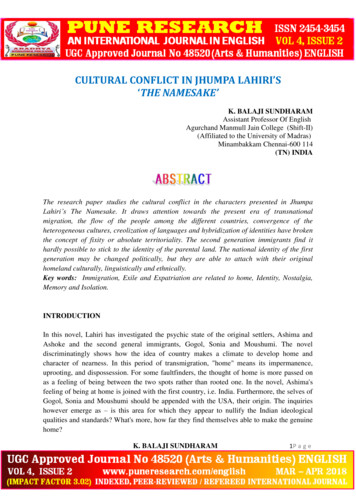
Transcription
CULTURAL CONFLICT IN JHUMPA LAHIRI’S‘THE NAMESAKE’K. BALAJI SUNDHARAMAssistant Professor Of EnglishAgurchand Manmull Jain College (Shift-II)(Affiliated to the University of Madras)Minambakkam Chennai-600 114(TN) INDIAThe research paper studies the cultural conflict in the characters presented in JhumpaLahiri’s The Namesake. It draws attention towards the present era of transnationalmigration, the flow of the people among the different countries, convergence of theheterogeneous cultures, creolization of languages and hybridization of identities have brokenthe concept of fixity or absolute territoriality. The second generation immigrants find ithardly possible to stick to the identity of the parental land. The national identity of the firstgeneration may be changed politically, but they are able to attach with their originalhomeland culturally, linguistically and ethnically.Key words: Immigration, Exile and Expatriation are related to home, Identity, Nostalgia,Memory and Isolation.INTRODUCTIONIn this novel, Lahiri has investigated the psychic state of the original settlers, Ashima andAshoke and the second general immigrants, Gogol, Sonia and Moushumi. The noveldiscriminatingly shows how the idea of country makes a climate to develop home andcharacter of nearness. In this period of transmigration, "home" means its impermanence,uprooting, and dispossession. For some faultfinders, the thought of home is more passed onas a feeling of being between the two spots rather than rooted one. In the novel, Ashima'sfeeling of being at home is joined with the first country, i.e. India. Furthermore, the selves ofGogol, Sonia and Moushumi should be appended with the USA, their origin. The inquirieshowever emerge as – is this area for which they appear to nullify the Indian ideologicalqualities and standards? What's more, how far they find themselves able to make the genuinehome?K. BALAJI SUNDHARAM1P a g e
In an obscure city of Massachusetts, Ashima's throb for forsaking the nation of origin isunderscored through envisioning the photo of the family in Calcutta. What's more, thesentiment sentimentality of past appears to relieve the throb and anguish of Ashima. Whenshe speaks the truth to conceive an offspring a youngster, her Indian ethnicity helps her toremember the customary social code and traditions of the Indian Bengali society“.women gohome to their parents to give birth, away from husbands and in-laws and household cares.”(The Namesake p.4). Again the singular climate in the clinic makes her recover the specificsnippet of the local existence of the Calcutta. The reference of the 'breaks of memory' canapropos be specified in this connection. Ashima's tension over conceiving an offspring andraising up the kid in the outsider area is piercingly uncovered“ it was happening so farfrom home, unmonitored and unobserved by those she loved, had made it more miraculousstill” ( p.6). As to immigrants' circumstance abroad, researchers like Rayaprol quotes Guptaand Ferguson as takes after follows “. Remembered places have often served as symbolicanchors of community for dispersed people. This has long been true of immigrants, who usememory of place to construct imaginatively their new lived world” (Aparna Rayaprol,Negotiating Identities: Women in the Diaspora 1992: (p 10-11)Essentially Ashima's memory of the children's song from the Bengali tunes, recognition of'dida I'm nearing' for 'farewell' are personally connected with the Bengali social traditionswhich is not really evadable for the original workers like Ashima. Her memory of the pastand creative energy of the present Calcuttan family life is exemplified inside of the wovenartwork of the disengaged life in the USA. Her sentiment sentimentality catches the exactsecond of the far away Calcuttan life where “a servant is pouring after-dinner tea . arrangingMarie biscuits on a tray” (p.5).In examination to Ashima's sentimentality, Gogol's aloof state of mind to Indian culture isbasically analyzed in the novel. The absence of tie with the Indian family makes Gogol rarelyperceive the photographs of the relatives of Ashima. Ashima attempts to transmit in Gogolthe tradition of the Bengal by presenting him with the Bengali rhyme, names of Gods andGoddesses and predominant Bengali convention of calling each kid by two names.By and large foreigners endeavor to etymologically tie themselves with their own country.The present novel likewise arranges this. The tie of the dialect extraordinarily the Bengali ofthe indigenous area is dared to make Ashima join with the Indian soil. The American Englishappears to be less critical to Ashima than the Bengali dialect in which she is usual with theCalcuttan life. Ashima's getting a handle on 'a tattered copy of desh magazine' in the remotehealing centre shows her transitory help in the far away nation. Ashima sometimes feelsuncomfortable with whatever other dialect yet the Bengali. The singularity of Ashima inK. BALAJI SUNDHARAM2P a g e
America appears to embody the present and the future too. Ashima's anxiety over rising upthe child without her family encompassing in this bizarre city, affects her to consider “. aperson entering the world so alone, so deprived” (p.25).The bipolarity of foreign the cultural exhibitions between the original and second generationIndian immigrants is seen in the present novel. Social execution by and large assumes aninstrumental part to develop settler's personality. The supporting of the Bengali societythrough Nazrul and Tagore melodies, contention over the movies of Ritwik Ghatak versusSatyajit Roy, and in addition wrangle over the political gatherings of the West Bengal amongthe Bengali outsider group in the USA outline their vicinity with the Indian soil. Socialexecution by and large assumes an instrumental part to build migrant's character. In theabroad nations, local social exercises, for example, moves or tunes build social character ofthe settlers and attempt to arrange with different societies as well (Aparna Rayaprol, 1997).Contrarily, the second generation immigrants like Gogol gets included with the Americanmusic than the Indian established music: “. a cassette of classical Indian music he'd boughtfor Gogol months ago still sealed in its wrapper” (p.78). The most extreme exertion ofAshima and Ashoke to make him familiar with social exercises like Kathakali dance and ApuTrilogy plays.Ashima's safeguarding of the fluctuated Bengali customs in the new land encapsulates thebond with local India. The party of Gogol's Annaprasan (rice function) according to theBengali tradition gives Ashima an interim help in this outside environment. Then again, toperform this custom, unlucky deficiency of the relatives eclipses Ashima which signifies heraching to make the Bengali environment in the new obscure nation. Ashima, Ashoke andBengali foreigners comply with the religious celebrations of Christmas and New Yearfestivity most likely to accommodate with the way of life.Conversely, the willingness and zeal of the second generation Bengali settlers is seen incommending the American celebrations than worshiping of Indian Gods and Goddesses.The disarray with respect to the names like Gogol, Sonali and Moushumi, the Americanconceived posterity of the Indian folks makes an issue characterizing their personalities. Thename like Gogol, Nikhil, Sonali and Moushumi demonstrate Russian and Indian personalitiesindividually than the Americans. The "self" of the male hero of the novel is inserted in theAmericanization, not in Indianness. In any case, Gogol may be considered as "other" in thisland, his origin. Ashima should be the "other" in the obscure American climate, as shegenerally watches the difference between the home and host societies.K. BALAJI SUNDHARAM3P a g e
Also, ethnic nourishment and outfit go about as the images of one's ethnic character. AshokeAshima's inclination for the Indian Bengali nourishment like rice, dal, and samosa and so onsymbolizes their mutual root. Then again, Gogol-Sonia's inclination for the Americancooking like Shake' n Bake chicken or Hamburger Helper than the Indian sustenance isbasically analyzed: “Gogol savors each mouthful, aware that for the next eight monthsnothing will taste quite the same” (p.81). Ashima's support of wearing customary sari thansome other western dresses passes on the safeguarding of the old familial culture.The dichotomy between Ashima's feeling of distance and singularity in the USA, regardlessof the delayed staying and Gogol-Sonia's hesitance and repetitive visit in India, is pointed outin the novel. Consequently, Gogol's coming back from India to Boston symbolizes his gettingaway from the dejection of India which as a rule extends his hesitance to arrange with theIndian environment“. for Gogol, relief quickly replaces a lingering sadness” (p.87). In thenew environment, Ashima's powerlessness to embrace with the social standards andframeworks and feeling of humiliation and anguish turns out in regards to bringing up childGogol. Her longing to move back to India is implanted in this singular climate:“I'm saying I don't want to raise Gogol alone in this country. It's not right. Iwant to go back” (p.33).Likewise, Gogol-Sonia's unconcerned disposition to acknowledge the Bengali traditions andcustoms appears to sidestep his Indian personality. Their hyphenated position, IndianAmerican, inside of two distinctive ethnic personalities gives them no particular character forthe conservation of the specific ideological estimation of any nation. The appearing to be wayof their adherence to the American traditions makes them to bestow less criticalness of theIndian one. Another circumstance can be seen through Gogol-Sonia's changed conduct oftrying to comply with the principles and regulations of the Indian religious service after theirdad's passing:“. It was a Bengali son's duty to shave his head in the wake of a parent’sdeath” (p.179).Consequently, the powerlessness of the second-generation settlers to make the genuine homeof nature and bond in America or in India for the most part can be broke down because of thecritical situation. Moushumi, the British conceived off-spring of the Bengali folks can be seenfrom the purpose of transnational. Her constant moving starting with one nation then onto thenext rarely makes her to stick to any specific social ideological estimation of the nations likeBritain, America and France. Subsequently, her belongingness is moving among diversenations rather than an altered nation.K. BALAJI SUNDHARAM4P a g e
Moushumi's inclination for the French Literature, nourishment and sentiment unity with theFrench companions more often than not means her compromise with the French environmentrather than the Bengali. Keeping up the separation from the Bengali get together means herreserved quality in this obscure air: “always with a book in her hand at parties” (p.192). Herdelicate married association with Gogol symbolizes her invalidation to stick to the sacredobligation of the marriage organization. Again her hesitant acknowledgment the surname"Ganguli" of the life partner in the codes and behaviours of the Bengali marriageestablishment, pinpoints her readiness to appreciate freedom and autonomy by being notrestricted under this specific or settled framework:“When relatives from India continue to address letters and cards to 'Mrs.Moushumi Ganguli,' “she will shake her head and sigh” (p.227).Her escape from the Bengali tradition and culture to stick to the French culture does notunequivocal her inclination at home with the later one. Moushumi's liquid personality has aplace with the fluctuated ethnic characters like the Bengali, the British, the American and theFrench. Her constant moving starting with one nation then onto the next should re-make thehome in France:“Here Moushumi had reinvented herself, without misgivings, without guilt(p.233).The drifting way of home and fluid identity are explained in her absence of feeling with thepast bond with local Calcutta, which she used to sustain in Calcutta and the USA. It is by allaccounts rises as remote, another area. Besides, she is dared to be joined with the USAthrough the rumination over the previous days crosswise over limit subsequent to comingback to Calcutta:“. To the city that was once home and is now in its own way foreign”(p.278).Henceforth, she would be sandwiched between the double societies and ways of life also. Thedepiction of Ashima by Jhumpa Lahiri helps us to remember the female hero Taralata, theBengali foreigner in the USA. The city of San Francisco never rises as the sweet old home inCalcutta however is just the spot of habitation with no connection:“I'm feeling just a little alien and uncomfortable, a tinge of not-belonging, inthe midst of such welcoming comfort .” (p.75).K. BALAJI SUNDHARAM5P a g e
Lahiri, Jhumpa. “The Namesake”, Boston Houghton Mifflin Company. 2003- Lahiri’s The Namesake.” Studies in Women Writers in English. Ed. MohitK. Ray and Rama Kundu. Vol. 4. New Delhi: Atlantic, 2005.- Kaur, Tejinder. “Cultural Dilemmas and Displacements of Immigrants inJhumpaLahiri’s The Namesake.” Studies in Women Writers in English. Ed. Mohit K. Rayand Rama Kundu. Vol. 4. New Delhi: Atlantic, 2005.K. BALAJI SUNDHARAM6P a g e
The research paper studies the cultural conflict in the characters presented in Jhumpa Lahiri’s The Namesake. It draws attention towards the present era of transnational migration, the flow of the people among the different countries, convergence of the heterogeneous cultures, creolizat
![JHUMPA LAHIRI [b. 1967] Interpreter of Maladies](/img/16/lahiri-interpreter-of-maladies-full-text.jpg)
